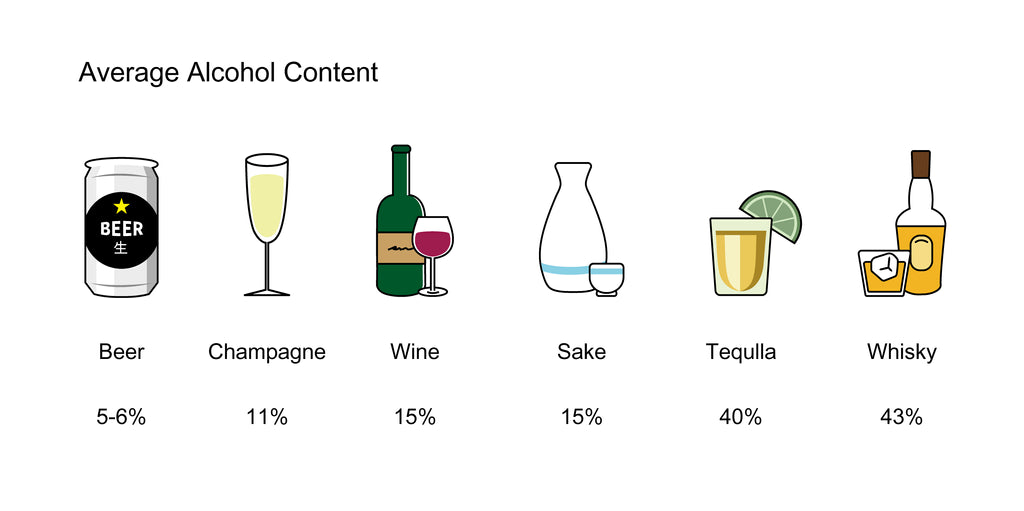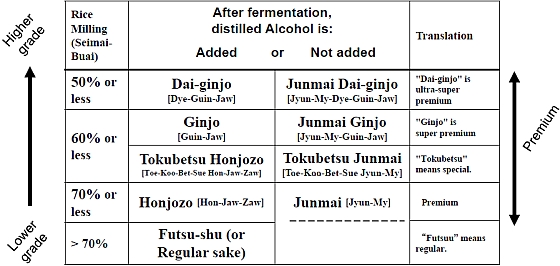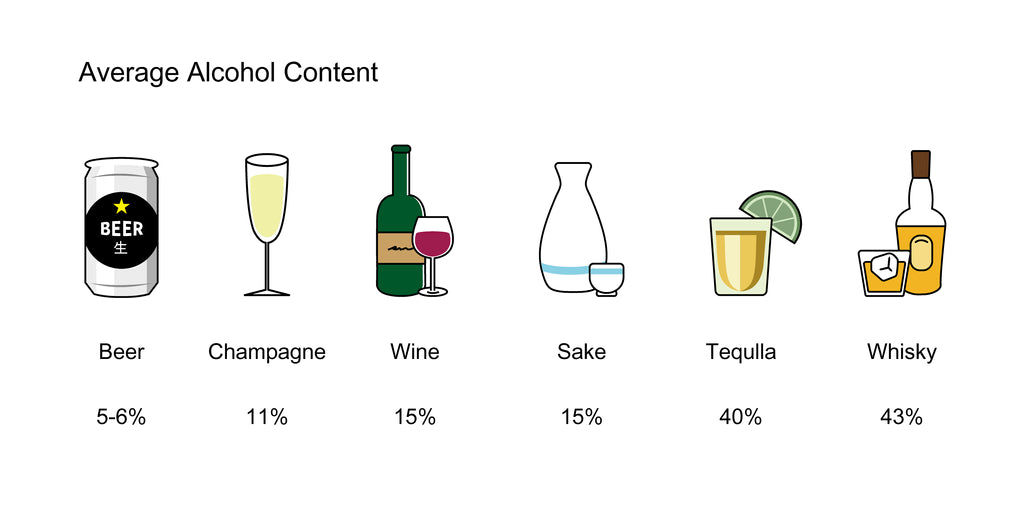
Introduction
Background Information On Alcohol Content In Sake
Sake, a traditional Japanese alcoholic beverage, has a unique characteristic that sets it apart from other types of alcohol – its alcohol content. In order to be officially classified as sake under Japanese law, the beverage must meet certain requirements, one of which is the alcohol percentage. Sake’s alcohol percentage must fall between 1% and 22%, giving it a wide range of strength options for consumers to choose from.
Why Understanding Alcohol Content In Sake Is Important
Understanding the alcohol content in sake is crucial for both seasoned sake enthusiasts and those new to the world of sake. Here are a few reasons why it is important:
- Flavor and aroma: The alcohol content affects the flavor and aroma profile of the sake. Sakes with lower alcohol percentages tend to have a lighter and sweeter taste, while those with higher alcohol percentages may have a bolder and drier flavor. By knowing the alcohol content, you can choose a sake that aligns with your taste preferences.
- Consumption and enjoyment: Sakes with different alcohol percentages may be consumed and enjoyed in different ways. Some individuals may prefer to sip on a sake with a lower alcohol percentage, while others may enjoy the warmth and intensity that a higher alcohol percentage brings. Understanding the alcohol content can help you determine how to best enjoy your sake.
Now that you understand the importance of alcohol content in sake, you can make informed decisions about the type of sake that suits your preferences. Whether you prefer a light and sweet sake or a bold and dry one, knowing the alcohol percentage can guide you to your desired flavor profile. Sake’s unique alcohol content adds another layer of complexity and enjoyment to this versatile beverage.
Sake: A Brief Introduction
Definition And Production Process Of Sake
Sake, a traditional Japanese alcoholic beverage, is known for its unique production process and distinct flavors. It is made from fermented rice, water, yeast, and koji, a type of mold that converts starches into sugars. The grains of rice used in sake production are polished to remove the outer layers, resulting in a purer and more refined taste. The production of sake involves several steps, including rice milling, washing, soaking, steaming, fermentation, and pressing. Each step is carefully monitored to ensure the desired taste and quality of the final product.
Historical Significance And Cultural Importance Of Sake
Sake holds a deep cultural significance in Japan and has been consumed for centuries as part of religious rituals, celebrations, and daily life. It is often referred to as “nihonshu,” meaning “Japanese liquor,” and is considered the national drink of Japan. Sake breweries, known as “sakagura,” have become cultural landmarks and tourist attractions, showcasing the artistry and craftsmanship behind sake production. Sake is not only enjoyed domestically but is also exported worldwide, spreading Japanese culture and traditions to different parts of the globe.
Sake’s popularity has grown beyond the borders of Japan, with enthusiasts around the world embracing its unique flavors and versatility. It can be enjoyed chilled, at room temperature, or warmed depending on personal preference and the characteristics of the sake. The wide range of alcohol content in sake allows for different flavor profiles, from light and fruity to rich and robust. Whether served in traditional ceramic cups or modern glassware, sake continues to captivate drinkers with its delicate balance of flavors and aromas.
In conclusion, sake is not just an alcoholic beverage; it is a symbol of Japanese culture and craftsmanship. Its production process, historical significance, and diverse flavor profiles make it a fascinating and enjoyable drink for enthusiasts worldwide. Whether you are new to sake or a seasoned connoisseur, exploring the world of sake can be a delightful journey of flavors and cultural exploration.
Average Alcohol Content In Sake
Comparison Of Average Alcohol Content In Popular Alcoholic Beverages
Generally, sake tends to have a higher alcohol content compared to other popular alcoholic drinks. Here is a comparison of the average alcohol content of sake with other beverages:
- Beer: 5% ABV
- Champagne: 11% ABV
- Wine: 15% ABV
- Sake: 15-16% ABV
- Shochu: 25-30% ABV
- Whiskey: 40% ABV
- Vodka: 40% ABV
- Tequila: 40% ABV
As you can see, sake falls within the range of 15-16% ABV, making it resemble a slightly stronger wine.
Explanation Of Sake’s Average Alcohol Content Of 15-16% ABV
The average alcohol content of sake is regulated by the Liquor Tax Law in Japan, which states that sake must have an ABV below 22%. The current liquor tax on sake is set at 216 yen per 1.8L bottle.
Sake’s high alcohol content can be attributed to the fermentation process. During production, rice is fermented with yeast and koji, a type of mold that converts starches into sugars. The fermentation process continues until most of the sugars are converted into alcohol, resulting in a higher alcohol content compared to beverages like beer or wine, which are typically produced through a shorter fermentation process.
It’s important to note that there are sake types with lower and higher alcohol content than the average. Some breweries produce sake with a lower ABV to cater to individuals who prefer a lighter and milder flavor profile. On the other hand, there are also sake varieties that have a higher alcohol content, often labeled as “genshu,” which is undiluted sake. These variations provide options for sake enthusiasts to explore different flavors and alcohol levels.
In conclusion, sake’s average alcohol content of 15-16% ABV places it in the realm of slightly stronger wines. The fermentation process and the regulations on alcohol content in Japan contribute to this characteristic. Whether you prefer a delicate and light sake or a robust and stronger one, there are options available to suit every taste preference.

Factors Influencing Alcohol Content In Sake
Rice Polishing Ratio And Its Effect On Alcohol Content
The rice polishing ratio plays a crucial role in determining the alcohol content of sake. The polishing process involves removing the outer layers of the rice grain, which contain proteins, fats, and other impurities. The more the rice is polished, the higher the purity of the starch within it. As a result, the starch can be more efficiently fermented into alcohol during the brewing process. Sake with a lower rice polishing ratio tends to have a higher alcohol content, while those with a higher ratio have a lighter and milder flavor profile.
Here is a comparison of the rice polishing ratios and their effect on alcohol content:
| Rice Polishing Ratio | Alcohol Content |
|---|---|
| 70%-80% | Higher alcohol content (16-20% ABV) |
| 50%-60% | Medium alcohol content (14-16% ABV) |
| 30%-40% | Lower alcohol content (12-14% ABV) |
Yeast Strains And Fermentation Techniques
The choice of yeast strains and fermentation techniques also influence the alcohol content of sake. Different yeast strains can produce varying levels of alcohol during the fermentation process. Some strains are known to generate higher alcohol content, while others produce a milder flavor profile with lower alcohol levels.
In addition to yeast, the fermentation techniques employed by sake breweries can further impact the alcohol content. Factors such as temperature control, duration of fermentation, and the addition of water or alcohol during the brewing process can all affect the final alcohol content of the sake.
Overall, the alcohol content in sake is influenced by multiple factors, including the rice polishing ratio and the choice of yeast strains and fermentation techniques. Brewers have the flexibility to create a wide range of sake varieties with different alcohol levels to cater to varying taste preferences. Whether you prefer a sake with a higher alcohol content or a lighter and milder option, there is a sake out there to suit your palate.
Extreme Highs And Lows: Unveiling The Variations In Alcohol Content
Exploration Of Sake With Higher Alcohol Content (30% ABV)
While the average alcohol content of sake hovers around the 15-16% range, it’s worth noting that there are variations that push the limits of alcohol content even higher. Some sake types can reach alcohol levels as high as 30% ABV. These high-alcohol sakes are often classified as “genshu” or undiluted sake, as they are not diluted with water before bottling. Genshu sakes can offer a more robust and intense flavor profile, making them a choice for those seeking a bold and higher alcohol drinking experience.
Relatively Lower Alcohol Content Variants Of Sake (6-8% ABV)
On the other end of the spectrum, there are sake varieties with lower alcohol content, typically ranging from 6-8% ABV. These sakes are known as “low-malt” or “sparkling” sakes. The lower alcohol content in these sakes is achieved through various methods, including dilution with water or carbonation. These lower-alcohol sakes can be a delightful option for those looking for a lighter and more refreshing drinking experience.
It’s important to note that the variations in sake’s alcohol content allow for diverse and unique drinking experiences. Whether you prefer a sake with higher alcohol content to savor its richness and complexity or opt for a lighter and more refreshing variety, the world of sake offers something for everyone.
Uncovering The Flavors: Alcohol Content And Taste Of Sake
The Relationship Between Alcohol Content And Flavor Profile
Sake, a traditional Japanese rice wine, offers a wide range of flavors and aromas, thanks to its varying alcohol content. The alcohol percentage in sake plays a significant role in determining its taste profile. Understanding the impact of alcohol content can help you make an informed choice when selecting a bottle of sake.
How Higher Alcohol Content Influences Sake’s Taste
When it comes to sake, higher alcohol content can result in a stronger flavor and a more pronounced aroma. Sakes with alcohol percentages around 30% ABV are considered high-alcohol varieties. These sakes, often called “genshu,” are undiluted and pack a punch. They offer a robust and intense flavor profile, making them suitable for those who appreciate a bolder drinking experience.
On the other hand, if you prefer a milder taste, seeking out sakes with lower alcohol percentages might be more suitable. These sakes, typically ranging from 6-8% ABV, are known as “low-malt” or “sparkling” sakes. The lower alcohol content is achieved through methods such as dilution with water or carbonation. These sakes provide a lighter and more refreshing drinking experience.
It’s important to note that alcohol content is just one factor influencing sake’s flavor. Other factors, such as the rice polishing ratio and brewing techniques, also contribute to the overall taste. Experimenting with different sake styles and alcohol percentages is key to discovering your personal preference and finding your favorite sake.
Whether you gravitate towards the boldness of high-alcohol sakes or prefer the delicacy of lower-alcohol varieties, the world of sake offers a diverse range of options to suit different palates. So, next time you explore the realm of sake, pay attention to the alcohol content and savor the unique flavors this traditional Japanese beverage has to offer.

Uncovering The Flavors: Alcohol Content And Taste Of Sake
The Relationship Between Alcohol Content And Flavor Profile
Sake, a traditional Japanese rice wine, offers a wide range of flavors and aromas, thanks to its varying alcohol content. The alcohol percentage in sake plays a significant role in determining its taste profile. Understanding the impact of alcohol content can help individuals make an informed choice when selecting a bottle of sake.
How Higher Alcohol Content Influences Sake’s Taste
When it comes to sake, higher alcohol content can result in a stronger flavor and a more pronounced aroma. Sakes with alcohol percentages around 30% ABV are considered high-alcohol varieties. These sakes, often called “genshu,” are undiluted and pack a punch. They offer a robust and intense flavor profile, making them suitable for those who appreciate a bolder drinking experience.
On the other hand, if one prefers a milder taste, seeking out sakes with lower alcohol percentages might be more suitable. These sakes, typically ranging from 6-8% ABV, are known as “low-malt” or “sparkling” sakes. The lower alcohol content is achieved through methods such as dilution with water or carbonation. These sakes provide a lighter and more refreshing drinking experience.
It’s important to note that alcohol content is just one factor influencing sake’s flavor. Other factors, such as the rice polishing ratio and brewing techniques, also contribute to the overall taste. Experimenting with different sake styles and alcohol percentages is key to discovering one’s personal preference and finding a favorite sake.
Whether individuals gravitate towards the boldness of high-alcohol sakes or prefer the delicacy of lower-alcohol varieties, the world of sake offers a diverse range of options to suit different palates. So, the next time you explore the realm of sake, pay attention to the alcohol content and savor the unique flavors this traditional Japanese beverage has to offer.
Diverse Ranges Of Alcohol Content In Sake
Discussion Of Different Categories Of Sake Based On Alcohol Content
Sake comes in various alcohol content ranges, allowing consumers to choose according to their preferences. The alcohol percentage in sake must be between 1% and 22% to be considered authentic. This range positions sake’s ABV to be greater than that of both beer and wine.
Overview Of Junmai, Honjozo, Ginjo, And Daiginjo Sake Types
Different types of sake have varying alcohol content, resulting in distinct flavor profiles. Here is an overview of some popular sake types and their characteristics:
| Sake Type | Alcohol Content | Characteristics |
|---|---|---|
| Junmai | 13-20% | Full-bodied, rich, and earthy flavor |
| Honjozo | 13-15% | Refreshing, crisp, and light-bodied taste |
| Ginjo | 15-17% | Fragrant, fruity, and smooth flavor |
| Daiginjo | 15-20% | Highly aromatic, refined, and elegant taste |
Understanding the alcohol content and characteristics of different sake types can help individuals choose a sake that aligns with their taste preferences.
Health Implications Of Sake’s Alcohol Content
Moderate Sake Consumption And Its Potential Health Benefits
Moderate consumption of sake can have potential health benefits. Studies have shown that moderate alcohol consumption, including sake, may have positive effects on certain aspects of health. Here are some potential benefits of moderate sake consumption:
- Heart health: Moderate sake consumption has been linked to a lower risk of heart disease. The antioxidants present in sake, such as amino acids and polyphenols, may contribute to this protective effect.
- Cognitive function: Some research suggests that moderate alcohol consumption, including sake, may be associated with improved cognitive function and a lower risk of dementia.
- Digestive health: Sake contains enzymes and good bacteria that can support healthy digestion. Additionally, it may help stimulate the appetite and improve nutrient absorption.
It’s important to note that these potential health benefits are associated with moderate consumption, which is defined as up to one drink per day for women and up to two drinks per day for men.
Risks Of Excessive Alcohol Consumption And Responsible Drinking
While moderate consumption of sake can have potential health benefits, it’s crucial to be aware of the risks associated with excessive alcohol consumption. Excessive drinking can lead to various negative health consequences, including:
- Liver damage: Heavy and prolonged alcohol consumption can cause liver damage, such as alcoholic hepatitis, cirrhosis, and liver cancer.
- Increased risk of addiction: Regular excessive drinking can lead to alcohol dependence and addiction.
- Impaired judgment and coordination: Excessive alcohol consumption impairs judgment, coordination, and reaction time, increasing the risk of accidents and injuries.
To enjoy sake responsibly and minimize the risks associated with alcohol consumption, consider the following tips:
- Set limits: Establish personal limits for alcohol consumption and stick to them.
- Alternate with non-alcoholic drinks: Drink water or other non-alcoholic beverages in between alcoholic drinks to stay hydrated and pace yourself.
- Never drink and drive: Always arrange for a designated driver or use alternative transportation when alcohol has been consumed.
- Seek professional help if needed: If you find it difficult to control your alcohol consumption or suspect you may have a drinking problem, reach out to a healthcare professional or support group for assistance.
By being aware of the potential benefits and risks associated with sake and practicing responsible drinking, individuals can enjoy this traditional Japanese beverage while prioritizing their health and well-being.
Health Implications Of Sake’s Alcohol Content
Moderate Sake Consumption And Its Potential Health Benefits
Moderate consumption of sake can have potential health benefits. Studies have shown that moderate alcohol consumption, including sake, may have positive effects on certain aspects of health. Here are some potential benefits of moderate sake consumption:
- Heart health: Moderate sake consumption has been linked to a lower risk of heart disease. The antioxidants present in sake, such as amino acids and polyphenols, may contribute to this protective effect.
- Cognitive function: Some research suggests that moderate alcohol consumption, including sake, may be associated with improved cognitive function and a lower risk of dementia.
- Digestive health: Sake contains enzymes and good bacteria that can support healthy digestion. Additionally, it may help stimulate the appetite and improve nutrient absorption.
It’s important to note that these potential health benefits are associated with moderate consumption, which is defined as up to one drink per day for women and up to two drinks per day for men.
Risks Of Excessive Alcohol Consumption And Responsible Drinking
While moderate consumption of sake can have potential health benefits, it’s crucial to be aware of the risks associated with excessive alcohol consumption. Excessive drinking can lead to various negative health consequences, including:
- Liver damage: Heavy and prolonged alcohol consumption can cause liver damage, such as alcoholic hepatitis, cirrhosis, and liver cancer.
- Increased risk of addiction: Regular excessive drinking can lead to alcohol dependence and addiction.
- Impaired judgment and coordination: Excessive alcohol consumption impairs judgment, coordination, and reaction time, increasing the risk of accidents and injuries.
To enjoy sake responsibly and minimize the risks associated with alcohol consumption, consider the following tips:
- Set limits: Establish personal limits for alcohol consumption and stick to them.
- Alternate with non-alcoholic drinks: Drink water or other non-alcoholic beverages in between alcoholic drinks to stay hydrated and pace yourself.
- Never drink and drive: Always arrange for a designated driver or use alternative transportation when alcohol has been consumed.
- Seek professional help if needed: If individuals find it difficult to control their alcohol consumption or suspect they may have a drinking problem, they should reach out to a healthcare professional or support group for assistance.
By being aware of the potential benefits and risks associated with sake and practicing responsible drinking, individuals can enjoy this traditional Japanese beverage while prioritizing their health and well-being.
Conclusion
Summary Of The Importance Of Understanding Alcohol Content In Sake
Understanding the alcohol content in sake is crucial for a more enjoyable sake experience. By knowing the alcohol percentage, individuals can make informed decisions about the flavors and strengths they prefer.
Appreciating The Versatility And Enjoyment Of Sake In Its Various Alcohol Percentages
Exploring different alcohol percentages in sake allows individuals to expand their sake palate and appreciate the versatility of this traditional Japanese drink. Whether one prefers milder or bolder flavors, there is a sake with the perfect alcohol content to suit their taste.
In conclusion, understanding the impact of alcohol content on sake is vital for an enjoyable sake experience. By being aware of the potential health benefits and risks associated with sake and practicing responsible drinking, individuals can fully appreciate the flavors and cultural significance of this traditional Japanese rice wine.
FAQ: Alcohol Content in Sake – Unveiling the Alcohol Percentage in Sake
- What is the alcohol content in sake?
The alcohol content in sake can vary considerably, ranging from around 15% to 20% alcohol by volume (ABV). However, there are also specialty sakes with an even higher alcohol content, known as “genshu,” which can be as high as 22% ABV. - What factors contribute to the alcohol content in sake?
The alcohol content in sake is determined during the fermentation process. Sake is made by converting the starches in rice into sugars, and then fermenting those sugars into alcohol. The higher the conversion of sugar to alcohol, the higher the alcohol content in the final product. - Are there different types of sake with varying alcohol percentages?
Yes, there are different types of sake categorized by their alcohol content. The most common types include:- Junmai: These sakes typically have an alcohol content of around 15% to 16% ABV. They are made from rice, water, yeast, and koji (a mold that helps with fermentation), without any added alcohol.
- Honjozo: These sakes have a similar alcohol content range as junmai sake but with a small amount of brewed alcohol added during the fermentation process. This addition helps to enhance the aroma and flavor of the sake.
- Ginjo: These sakes have a higher alcohol content, usually ranging from 15% to 17% ABV. They are made from rice that has been polished to at least 60% of its original size, resulting in a smoother and more fragrant sake.
- Daiginjo: These sakes have an alcohol content similar to ginjo sake, but they are made from rice polished to at least 50% of its original size. Daiginjo sakes are often characterized by their complex flavors and delicate aromas.
- How can I determine the alcohol content of sake?
The alcohol content of sake is usually indicated on the bottle label, typically listed as a percentage, such as “15% ABV.” This information helps consumers make informed choices based on their preferences. - Is the alcohol content in sake the same as wine or spirits?
No, the alcohol content in sake generally falls within a different range compared to wine and spirits. While wine typically ranges from 12% to 15% ABV, and spirits can vary from 35% to 50% ABV or more, sake occupies a unique middle ground with its alcohol content. - Can the alcohol content affect the taste of sake?
Yes, the alcohol content can affect the taste of sake. Sakes with a higher alcohol content tend to have a stronger, more pronounced flavor and a drier finish. Lower alcohol content sakes may be milder and sweeter in taste. The alcohol level can also impact the overall balance and mouthfeel of the sake.
Additional Tips:
When enjoying sake, it’s important to savor it responsibly. The alcohol content can vary, so it’s essential to be aware of the percentage and drink accordingly. If you’re unsure about the alcohol content or its effects, consider consulting with a sake expert or exploring reputable sources to enhance your understanding.

New Life Juice Bar & Lounge (NLJB) is a vibrant and inviting organic, all-natural juice bar dedicated to providing a warm and friendly environment for all juice enthusiasts. From the moment you step through our doors, you’ll feel the positive and energizing vibes that make NLJB a must-visit destination. Our journey began with a vision to create a space where people could embrace a healthy lifestyle while enjoying delicious and nutritious organic juices. We are passionate about using only the freshest, locally sourced ingredients to craft our diverse menu of organic offerings. Whether you’re craving a rejuvenating green juice, a refreshing fruit smoothie, or a detoxifying cleanse, NLJB has something to tantalize every taste bud.